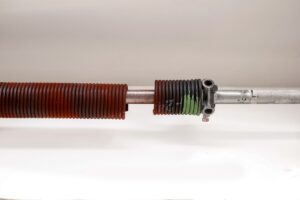
How Garage Door Counterbalance Systems Work
(And Why They Matter)
Quick Answer: What is a Counterbalance System?
A garage door counterbalance system uses springs and cables to offset the heavy weight of the door, making it possible to lift manually or with an opener. Without this system, most garage doors—often weighing between 200 and 400 pounds—would be impossible to operate safely.
Signs of counterbalance trouble include:
- Door feels unusually heavy.
- Opener strains, stalls, or makes grinding sounds.
- Door slams shut instead of closing smoothly.
- Visible gaps in the spring coil.
- Uneven or crooked travel.
- Door won’t stay open during a balance test.
If you notice these symptoms, it’s time to have your garage door system checked by a professional.
Why This Post Matters to Huntsville and Surrounding Metro Areas
Here in the Huntsville metro, people come from all over with different ways of describing the same garage door problem. Some say their door isn’t “balanced,” others ask about the “counterbalance,” and sometimes it’s just, “why won’t this heavy thing move?” That makes sense—after all, we live in one of the best places to live in the U.S., ranked 7th by U.S. News & World Report. With so many new families moving in, everyone brings their own way of explaining what’s happening.
It only makes sense that we’d each have our own way of communicating when you call into our office. That’s why we felt it was important to go a little deeper here than we did in our earlier post, Is My Garage Door Unbalanced? Identifying and Troubleshooting an Unbalanced Garage Door. This time, we’ll focus specifically on counterbalance systems, how they differ from general “balance,” and why that distinction matters for safety, reliability, and your opener’s health.

The Hidden Science Behind Every Garage Door
At first glance, your garage door looks simple: press a button and it goes up, press again and it comes down. But behind that convenience is a carefully engineered system working quietly to keep everything safe and smooth.
The counterbalance system is the unsung hero. Whether you have a steel, wood, or insulated door, it’s this system that keeps a 200–400 lb door from crashing down or overloading your opener.
Here in Huntsville, Madison, Athens, and Decatur, many families use their garage as the main entryway. Kids running in and out, pets needing attention, daily errands—it adds up to thousands of open-and-close cycles per year. That daily use makes a healthy counterbalance system even more critical for North Alabama homeowners.
What Exactly Is a Counterbalance System?
A counterbalance system uses springs and cables to offset the door’s weight. This makes the door feel much lighter than it really is. A properly functioning system allows most people to lift the door with just one hand.
There are two primary types used in residential garage doors:
- Torsion springs
- Extension springs
Related Reading: Everything you need to know about garage door springs is on this page!

How Torsion and Extension Systems Work
Torsion Springs
- Located horizontally above the door opening.
- Use torque (rotational force) to balance the door.
- Provide smoother, more controlled lifting.
- Longer-lasting and generally safer, since they’re mounted on a shaft.
Extension Springs
- Located vertically, running along the sides of the tracks.
- Stretch and contract as the door moves.
- Rely on safety cables to prevent accidents if a spring breaks.
- More common in older garage door systems.
Most modern installations today use torsion spring systems because of their durability, safety, and efficiency. However, many older homes in North Alabama still operate with extension systems, making professional maintenance essential.
Counterbalance vs. “Door Balance”
The Key Difference
Many homeowners confuse the counterbalance system with whether the door is in balance. Here’s the difference:
- Counterbalance system = the overall spring-and-cable setup that makes the door operable. Every garage door has one.
- Balance = how well the counterbalance system is tuned. A door can still have springs but be out of balance if the springs lose tension, cables stretch, or components wear out.
Think of it this way: counterbalance is the engine, balance is the tune-up. Both matter.
Clarifying the Difference
Every garage door has a counterbalance system, but not every door stays properly balanced. The counterbalance is the set of springs and cables that make lifting possible. Balance refers to how well that system is adjusted. A door can have a counterbalance in place yet still be out of balance if the springs lose tension, cables stretch, or parts wear out.
Why Counterbalance Systems Matter
- Safety First
Garage doors are heavy. Without counterbalance, a door could come crashing down, posing a serious risk to children, pets, vehicles, or anyone nearby. - Protects Your Opener
Openers are not designed to lift the full weight of the door. They’re built to lift a door that’s already counterbalanced. If the system fails, the opener strains and often burns out early. - Smooth, Quiet Operation
A balanced counterbalance system allows for smoother, quieter door operation. This matters most in homes with attached garages near living or sleeping spaces. - Extends the Life of Your Components
From springs to rollers and cables, every component lasts longer when the counterbalance system is working correctly.
Signs of Counterbalance Trouble
If your counterbalance system isn’t functioning properly, your garage door will let you know. Watch for:
- The door feels heavier than normal.
- Opener strains, stalls, or makes grinding noises.
- The door slams shut instead of closing gently.
- You see a visible gap in the spring coil.
- Door appears crooked or jerky when moving.
- Cables look loose or out of place.
- During a balance test, the door won’t stay open at waist height.

How to Perform a Counterbalance Test (For Homeowners)
You can perform a safe, basic balance test at home:
- Close the garage door fully.
- Disconnect the opener by pulling the emergency release cord.
- Lift the door manually to waist height.
- Let go carefully.
If the counterbalance system is healthy, the door should stay in place or drift very slightly. If it slams down or flies upward, the springs are out of balance and need professional adjustment.
Important: This test is diagnostic only. Do not attempt to adjust springs or cables yourself.

Why Adjusting Counterbalance Is Not a DIY Job
Garage door springs are under extreme tension. Attempting DIY repairs without training and the right tools can cause severe injury—or worse. Even experienced technicians handle springs with caution.
Incorrect adjustments can:
- Damage your garage door opener.
- Warp or crack door panels.
- Cause the door to fall unexpectedly.
Related Reading: Why Do Garage Door Springs Break?
When to Call a Professional
- If the door feels heavy.
- If the opener strains or won’t lift.
- If cables look loose or the spring has a visible gap.
- If the door slams shut or won’t stay open during a test.
Huntsville and North Alabama homeowners often wait until a spring breaks before calling—but the signs of counterbalance trouble usually show up earlier. Addressing them promptly saves money, prevents damage, and protects your family’s safety.
FAQs About Garage Door Counterbalance Systems
Q: Can I open my garage door if the counterbalance spring breaks?
A: No. Without a functioning spring, the opener can’t lift the full weight of the door, and attempting to force it can damage the opener or cause injury. Read more about opening a garage door with a broken spring.
Q: How long do garage door springs last?
A: Most are rated for 10,000–15,000 cycles (one open/close = one cycle). In households where the garage is the main entry, that may mean 7 years or less.
Q: What’s the difference between torsion and extension springs?
A: Torsion springs, mounted above the door, use torque for smoother, safer operation. Extension springs stretch along the tracks and require safety cables.
Q: Is lubrication important for the counterbalance system?
A: Yes. Regular lubrication helps prevent rust and reduces friction, extending the life of springs and other moving parts. Read more about how to properly lubricate garage door components.
Q: How do I know if my counterbalance needs adjustment?
A: If the door won’t stay at waist height when disconnected from the opener, or feels unusually heavy, the counterbalance likely needs professional attention.

Local Perspective: Why Counterbalance Matters in North Alabama
In our community, many families use the garage as the main entry to the home. That means springs cycle thousands of times a year, wearing out faster than in households where the garage is secondary.
Add in North Alabama’s hot, humid summers, which accelerate rust and wear, and it’s easy to see why counterbalance maintenance is so important.
At Overhead Door Company of Huntsville/North Alabama™, we keep a wide inventory of springs in stock, so most repairs can be completed the same day. That’s something online competitors and out-of-town subcontractors simply can’t offer.
Final Thoughts
Your garage door’s counterbalance system is more than a mechanical detail—it’s the safeguard that makes daily convenience possible. When tuned correctly, it protects your opener, prevents dangerous accidents, and ensures smooth, quiet operation.
Whether you’re in Huntsville, Madison, Decatur, or Athens, keeping your counterbalance system in top condition is essential for safety and peace of mind. Call 256-772-3674 or visit our contact us page to schedule a service. Our team has been serving North Alabama homeowners since 1968, and we’re here to help with repairs, maintenance, and professional advice.
For more troubleshooting tips, visit our Troubleshooting Guide!
Reach Out To Us to Schedule a Service Call
Key Takeaways
- Counterbalance systems make heavy garage doors safe and operable.
- A failing counterbalance strains your opener and shortens its lifespan.
- Signs of trouble include heavy operation, slamming, or visible spring gaps.
- Regular maintenance prevents costly repairs and safety hazards.
- Professional adjustment is essential for safe, long-term performance.
Disclaimer
The information in this post is provided for educational purposes only. Garage door counterbalance systems involve components under extreme tension that can cause severe injury if handled improperly. For safety and proper operation, adjustments should only be performed by trained professionals. Overhead Door Company of Huntsville/North Alabama™ assumes no responsibility for injuries or damages resulting from DIY repairs.







